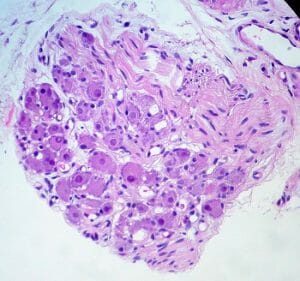Parasympathetic Nervous System Definition
The parasympathetic nervous system, or PSNS, is part of the nervous system. The nervous system sends signals to and from different body parts via nerves. The PSNS is responsible for all the bodily activities that take place when an animal is at rest. For this reason, the PSNS is known as the “rest and digest” part of the nervous system. These actions can include digesting food, excreting waste, crying, salivating, or becoming sexually aroused. The counterpart of the PSNS is the sympathetic nervous system (SNS), which is responsible for “fight or flight” activities that occur when an animal is deciding to fight another or flee.
Function of the Parasympathetic Nervous System
The parasympathetic and sympathetic nervous systems are collectively known as the autonomic nervous system. This division of the nervous system regulates bodily actions that happen without conscious thought. The PSNS works in conjunction with the SNS in order to maintain homeostasis in the body. For example, during a fight or flight response, the SNS increases heart rate and blood pressure. Afterward, the PSNS works to slow the heart rate down and lower blood pressure. It also starts up bodily processes that were temporarily put on hold when the SNS was activated, such as digestion. During periods of rest, the body can devote energy to processes that are not directly involved with fighting or fleeing.
Parasympathetic nerves begin in the medulla of the brain and at the middle area of the spinal column, which contains the spinal cord. One of the nerves in the medulla is the vagus nerve, which is a part of the body that helps control the heart, lungs, and digestion organs. The brain and spinal cord are important structures in the nervous system; together, they make up the central nervous system (CNS). The nerves of the PSNS that originate in the brain are called cranial nerves. Ganglia, or groups of nerve cell bodies, are extensions of the nerves of the PSNS, and are found near or in the organs of the body in order for signals to be sent to their target areas.
The PSNS and SNS regulate many parts of the body such as heart muscles, blood vessels, muscles of the digestive system, and glands such as the salivary glands and adrenal glands (which produce epinephrine, also called adrenaline, during fight or flight). During a period of fight or flight, the pupils dilate to allow us to see more clearly and make faster decisions. During rest and digest, the PSNS causes the pupils to constrict. The PSNS also causes increased digestion of food to occur, increased saliva and mucous production, and increased secretion of urine from the kidneys.
This is an image of a parasympathetic ganglion.
Parasympathetic and Peripheral
The parasympathetic nervous system is not to be confused with the peripheral nervous system (PNS). As mentioned previously, the brain and spinal cord make up the CNS. The PNS consists of all the parts of the nervous system that are not the brain and spinal cord; in other words, all the nerves and ganglia that are not in the brain and spinal cord are part of the PNS.
Nerves of the PSNS originate in the brain or spinal cord, but most of the PSNS is not located in these regions, and it affects other areas of the body, so it the PSNS is considered part of the PNS. But not all of the PNS is PSNS. The PNS also includes the sympathetic nervous system and the somatic nervous system (SoNS), which controls voluntary body movements.
To summarize the different divisions of the nervous system: the parasympathetic nervous system controls “rest and digest” actions, and the sympathetic nervous system controls “fight or flight” actions. These systems make up the autonomic nervous system, which controls unconscious bodily actions. The somatic nervous system controls all voluntary body movements, such as walking or catching a ball. Parts of all of these systems make up the peripheral nervous system, which is all the parts of the nervous system not including the brain and spinal cord. The brain and spinal cord make up the central nervous system.
Related Biology Terms
- Sympathetic Nervous System (SNS) – Controls “fight or flight” bodily actions, such as increasing heart rate and raising blood pressure.
- Autonomic Nervous System (ANS) – Controls the mostly unconscious actions of internal organs, and consists of the parasympathetic and sympathetic nervous systems.
- Somatic Nervous System (SoNS) – Controls voluntary body movements of the skeletal muscles.
- Peripheral Nervous System (PNS) – Parts of the nervous system that are not the brain and spinal cord, such as the nerves and ganglia found throughout the body.
Quiz
1. Which is NOT a function of the parasympathetic nervous system?
A. Lowering blood pressure
B. Lowering heart rate
C. Dilating pupils
D. Increasing digestive activities
2. What divisions of the nervous system are parts of the parasympathetic nervous system classified as?
A. The somatic nervous system
B. The autonomic nervous system
C. The peripheral nervous system
D. Both B and C
3. Why is the parasympathetic nervous system called the “rest and digest” system?
A. It solely controls the actions of sleeping and digesting.
B. It controls activities that take place when the body is at rest and not deciding whether to face an opponent or run from it.
C. It increases the heart rate and activates the adrenal glands, which allow the body to digest more efficiently.
D. It begins immediately after eating and ends immediately after resting.

